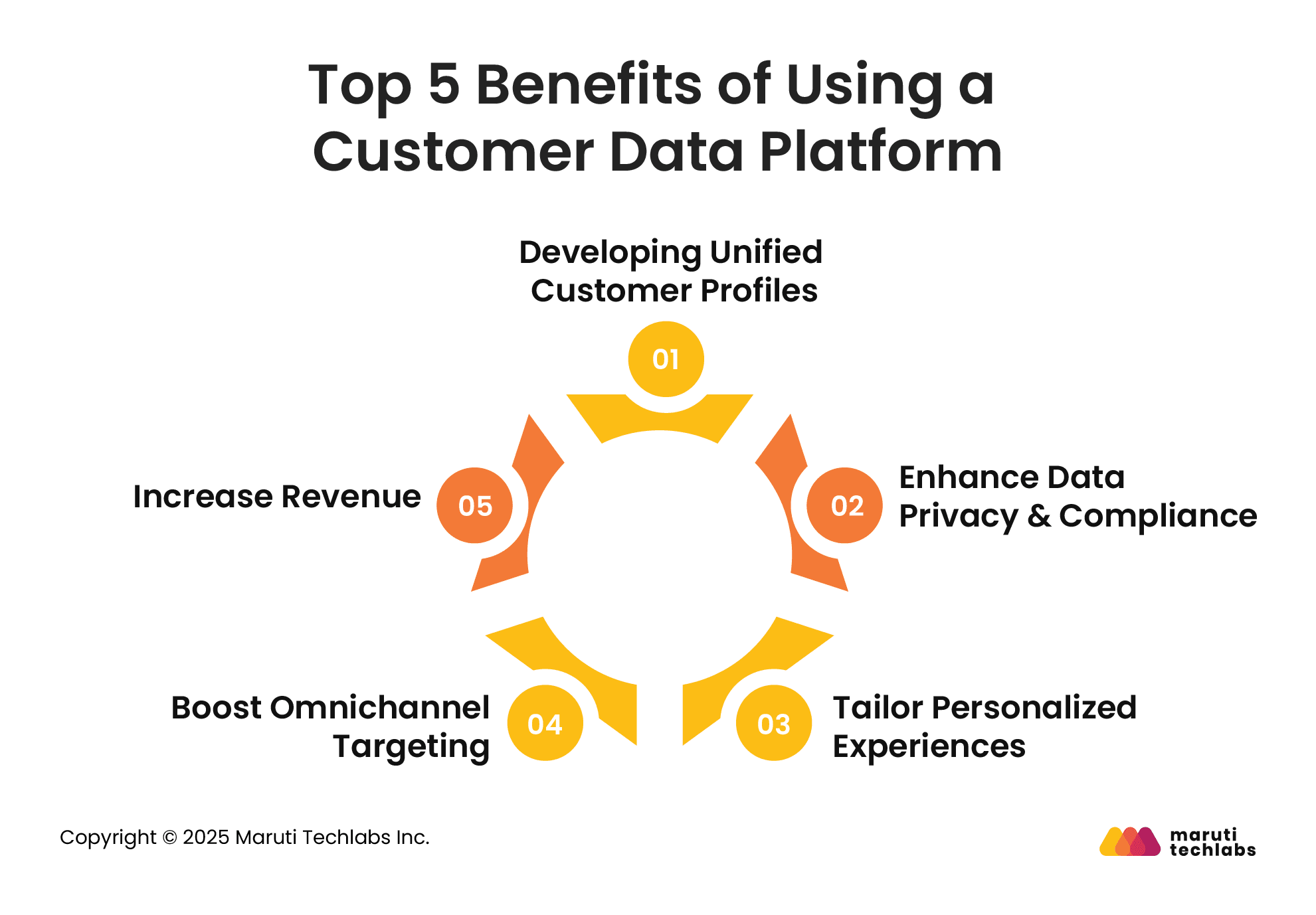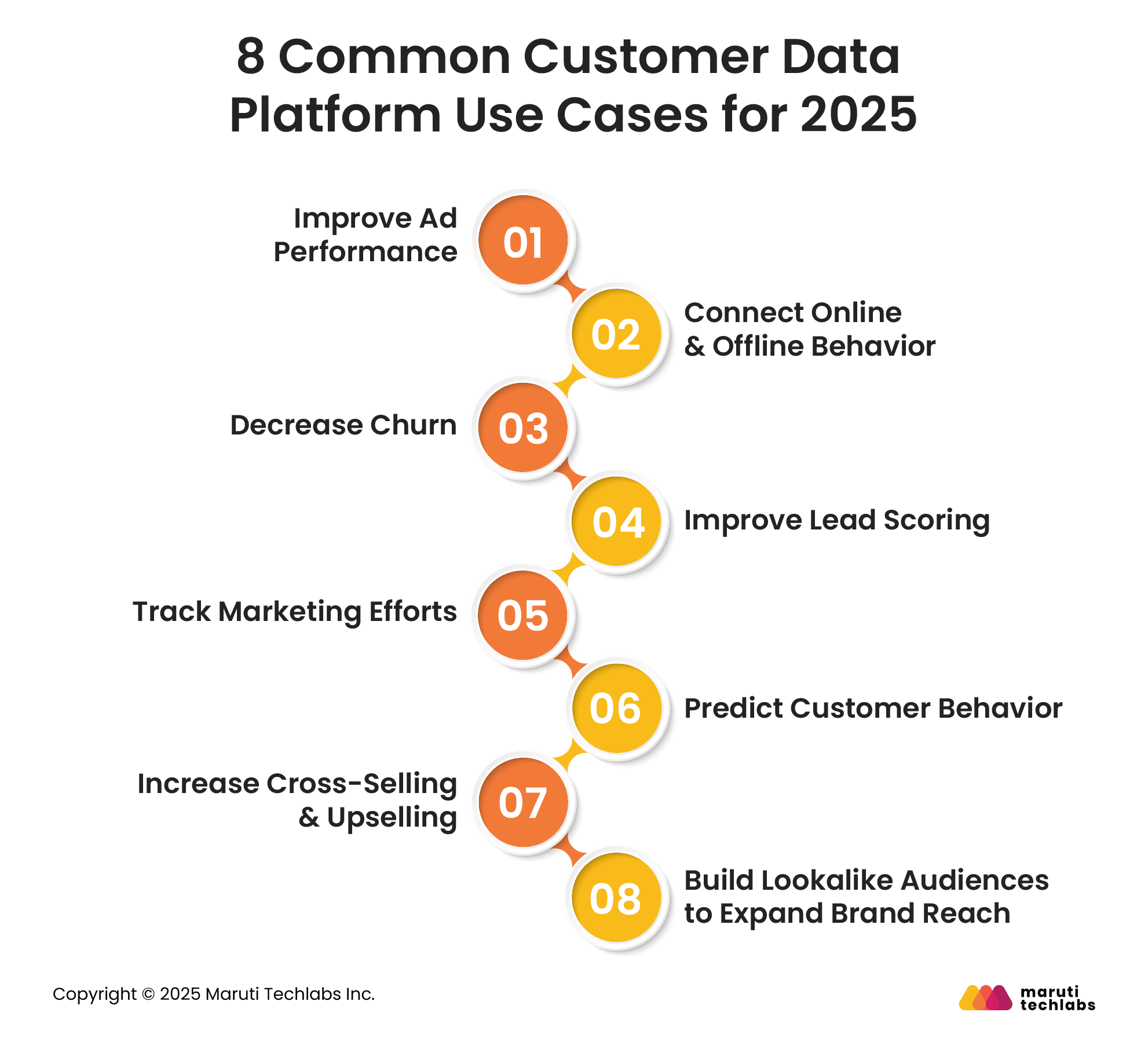

How CDPs Help You Turn Customer Data into Growth






In an era of constantly evolving customer expectations, businesses need more than analytics—they need unified, actionable insights. That’s where Customer Data Platforms (CDPs) come in.
CDPs are purpose-built to collect, unify, and activate first-party customer data across all touchpoints, enabling personalized experiences, real-time engagement, and deeper analytics.
This guide is designed specifically for marketing and analytics leaders seeking to navigate the complexities of CDPs. Whether you're overwhelmed by vendor options, unsure how CDPs differ from traditional CRMs, or looking to drive higher ROI from data investments, this guide is for you.
In our blog, we’ll decode CDPs' key capabilities, explain how they drive growth, and discuss critical considerations for selecting and implementing the right solution.
Remember the last time you purchased that watch online. You probably followed the following steps to conduct your research:
When you narrowed in on the watch, you may have searched for the best place to buy it, comparing costs, shipping times, return policies, and more.
There is a high chance that the company you finally bought it from interacted with you on multiple occasions during this process. This could be through Facebook or Google ads, emails, live chat, mobile apps, or website visits.
You might’ve noticed that each time you interacted with us, the experience became more personalized. The ads would’ve been more relevant, the website provided you with subtle personal changes, and the email follow-up that finally convinced you to buy the product.
How do you think the company was able to do all of this? It’s possible that they tailored their marketing efforts towards you using a Customer Data Platform (CDP).
“A Customer Data Platform is a software that amalgamates all the data from different tools and touchpoints, offering a centralized repository of all the customer’s interactions with your product or service. This data can then be used in various permutations and combinations to devise a marketing campaign personalized to you.”
A CDP primarily improves the effectiveness of your marketing campaigns. They do so by leveraging data-backed insights to personalize experiences at scale. Here’s how they do this.
CDP provides the convenience of using structured, unstructured, and semi-structured data to offer a single customer view.
It can ingest data from emails, social media, CRMs, ERPs, and more. CDPs can segment customer profiles by applying rules or machine learning, conduct predictive scoring, and orchestrate customer journeys.
CDPs use pre-built connectors or APIs to connect with your current tech stack easily. This adds agility, flexibility, and scalability, allowing you to use the best-in-class software for your industry.
CDP facilitates data democratization across an organization’s departments, such as sales, marketing, customer service, and support. It fosters tailored communication and builds lasting relationships to improve retention and lower churn. CDPs also favor high retention rates and reduce customer acquisition costs.
CDPs improve the omnichannel customer journey by enhancing the availability of customer data to other departments for campaigns. It provides insights to marketers to perform advanced personalization, segment key audiences, offer relevant content recommendations, and implement strategic retargeting.
A CDP uses built-in connectors, SDKs, webhooks, and APIs to connect to numerous tech platforms, data sources, and channels. It compiles and collects data from disparate sources, including campaign data, real-time interactions, product data, POS, marketing, customer support data, and more.
Leveraging this data, a single unified customer profile is developed. This process is known as data unification or identity resolution. Customer identity resolution uses algorithms to weave identifiers from different systems and automate graph creation, continual data unification in a profile, and increasing customer real-time interactions.
The unification process involves data validation and cleansing to develop a single customer view. Profiles are then enhanced with first, second, and third-party data sources to add missing attributes and fill them with more current information.
It then segments customer profiles using machine learning and performs predictive scoring. In addition, its customer journey orchestration capabilities also allow marketers to scrutinize customer interactions and execute proper marketing, choosing the right time and channels.
Here are six steps to help you choose the perfect CDP for your firm.
Different departments across the organization will use the CDP you choose. Therefore, it’s important to bring internal stakeholders into the picture before you reach a final decision. A primary question to ask is, ‘What departments in your firm need a CDP?’
For instance, your sales team, which already uses a customer relationship management (CRM) platform, should be compatible with your CDP. So, a member of your sales team would be a stakeholder.
However, each stakeholder doesn’t need to be part of the evaluation process. You just need their inputs on their specific needs, why you want to invest in a CDP, and what you plan to extract from it.
It’s critical to get clarity on why you need a CDP. Is it because it will consolidate all your data in a single database? However, consolidated data won’t do the trick or instantly make you more data-driven. You must define your use cases ahead of time.
While brainstorming this with your stakeholders, many use cases may come to mind, but you must narrow down to at least three ideal use cases to make an informed decision.
Three common use cases include:
Your defined use case will help you scrutinize your potential CDPs more comprehensively.
After defining your use cases, conduct in-depth research on your potential CDPs. Browse their websites, read product reviews, talk with colleagues from other companies who use these tools, and more.
You’ll need to connect different tools to your CDP. To know which tools you’ll need or are compatible with your CDP, you can analyze your most important use cases from step 2.
Your CDP must integrate with email platforms, CRM systems, website tools, and more. To avoid missing any critical tools you must incorporate, double-check with all the stakeholders you’ve invited for brainstorming sessions in step 1.
As a final step, ensure the CDPs you evaluate offer compatibility with the tools you need. To narrow your list, eliminate the platforms that don’t integrate the majority of the tools you need.

CDPs offer more value than a data consolidation platform or solving your use cases. You must also study the other requirements for your CDP. Requirements are more like features as opposed to an outcome.
Here is a standard list of requirements that companies generally have:
The pricing page of a CDP generally presents a complete list of requirements offered by the CDP. Observe all the features and make a complete list of missing or essential ones that it doesn’t provide.
At this stage, you should have a final list of your CDPs with the required features, integrations, requirements, and use cases.
You can begin by choosing a CDP according to your industry. Look for CDPs with customers similar to your organization. Whether you’re a start-up or an enterprise-level company, consider CDPs that are competent and experienced and can offer services at your level.
As a checklist, make sure your CDP has:
This is the last piece to completing your puzzle. ROI isn’t choosing the cheapest option, but what offers the most value for your needs and investment. How can you determine this without making an investment?
For instance, your engineers spend hours creating and maintaining integrations for a tool. These hours are explicitly invested in building and sustaining one integration. So, if you have 10 integrations, imagine the manpower and time you’ve to invest to manage them.
These costs are one of the biggest reasons for using a CDP. If the CDP you choose doesn’t offer significant time savings to your engineers, it may not be worth investing in. Therefore, calculating ROI before making a purchase is crucial.
Here are the top 5 reasons marketing and analytics teams should invest in a CDP.

CDP is adept at creating single customer views (SCVs), also known as 360-customer views. These profiles are created for a single customer using data gathered from all touchpoints. They give a unified view of a customer’s purchase history, information, Behaviors, and interests.
For instance, it records all interactions between customers and brands, whether they read a blog, search for a product, leave a product, add it to the cart, remove it from the cart, and more. This gives marketers clarity and helps devise more personalized experiences for customers.
Customers willingly share their first-party data in return for more tailored digital experiences. In making this exchange, they expect their information to be handled responsibly.
Customer Data Platforms (CDPs) support this by integrating various data sources, building comprehensive and current customer profiles, and enabling rapid access. This helps brands safeguard data and remain compliant with privacy regulations.
Digital experiences must be personalized for customers to build a connection with your product or service. Observing a unified view of customer interactions helps brands classify experiences that will be more relevant and personalized.
This includes presenting what your customers want to hear and deciding the touchpoints from where these interactions would be most meaningful, even with their changing preferences.
A primary advantage of using a CDP is collecting and analyzing data from numerous channels and creating dynamic experiences that coincide with customers’ Behaviors and needs.
CDPs gather actionable customer insights to curate experiences across mobile, web, social media, and email channels. As a unified profile is the source of these designed experiences, CDPs are proficient at creating a consistent personal journey even with customers' evolving needs.
CDPs effectively use customer data. By leveraging SCVs, organizations can develop more personalized experiences, enhance brand engagement and loyalty, and subsequently increase conversion rates and revenue.
As per a report from McKinsey personalization can improve revenues by 5–15% and enhance the efficiency of marketing spend by 10–30%.
Let’s learn the 8 most common use cases of CDPs, which are transforming how businesses understand and communicate with their customers.
When data is scattered across platforms like Facebook Ads, Google Ads, TikTok, or more it’s difficult to decide on tactics to improve ROI. CDPs help know your audience, enhance targeting, and surge ad performance across channels.
With a CDP, businesses can share audience segments with other platforms as custom audiences and unify data in a single location to inform and guide their strategy.
Connecting online and in-person, behavior has always been a challenge for brands. CDPs can gather data from the point of sale platform or reward program. This data can then be connected with online behavior, offering a 360-degree view of the customer journey.
For instance, a retailer might let customers place orders through an app for in-store pickup. When the customer arrives, the app could display personalized product recommendations or exclusive discounts based on their in-app activity. Starbucks’ rewards app is a great real-world example of this approach.
Acquisition costs are substantially higher than retention costs. CDP helps spot users at risk of churn and works to retain them.
For instance, customers who don’t access your app twice a week are more likely to leave. You can proactively share training videos or ask salespeople to help them with onboarding when they appear to need support. You can also prepare a list of such customers and perform a drip campaign to show the value your brand delivers.
‘Right lead, Right time’ is what lead scoring helps marketers and sales teams with. Analyzing data from different platforms helps marketing and sales teams learn which leads offer higher value.
For example, an e-commerce business can use enriched data to identify leads who interact across various channels or fit their ideal profile, then trigger automated emails or enhance the precision of retargeting campaigns.
Lead scoring is also critical for B2B companies, which prioritize high-value leads. Today, CDPs also use AI and ML to predict lead conversion probability.

A CDP helps you understand which marketing activities deliver results by tracking a customer's journey.
From their primary interaction to a purchase, whether a customer gets in touch from a Facebook Ad, later opens an email, or makes a final purchase from a Google Ad, attribution connects all these touchpoints to help you know what’s working.
Traditional analytics tools tracked past actions like page visits but didn’t predict what users might do next. In contrast, Customer Data Platforms (CDPs) pull data from multiple sources and apply machine learning and AI to anticipate future behavior based on historical patterns.
With these predictive insights, companies can better plan for traffic surges, manage inventory, or fine-tune future marketing spend. This kind of forward-looking data can also estimate a visitor’s likelihood to convert, unsubscribe, or engage with an email, empowering smarter, more proactive decisions.
Online platforms can increase cross-selling and upselling opportunities by gathering data about specific transactions and sharing personalized recommendations.
For example, an e-commerce site can visualize if a customer has purchased a pair of running shoes and can recommend socks or protein powder.
CDP also assists with improving targeting options across platforms. CDPs allow businesses to target ads more effectively and discover new audiences by combining data from multiple platforms.
For instance, you could study an audience segment from Google Ads and leverage it to replicate an audience base in Facebook Ads.
Customer Data Platforms (CDPs) unify disparate data sources into a single customer view, enabling real-time segmentation, behavioral predictions, and personalized engagement.
Their ability to combine, clean, and activate customer data across channels enhances campaign performance and drives measurable ROI across marketing and analytics initiatives. By breaking silos and powering decision-making with filtered, connected data, CDPs form the foundation for scalable, intelligent customer experiences.
At Maruti Techlabs, our Data Engineering Services go beyond CDP integration—we help you build custom data products tailored to your unique business goals. From designing pipelines that centralize multi-source data to developing data models for optimized analytics, we create scalable data systems that support your marketing, sales, and product teams
Whether you're aiming to improve churn prediction or drive hyper-personalized engagement, we architect the right data foundation to fuel results. Connect with us to turn your customer data into your biggest growth lever.
A Customer Data Platform (CDP) unifies data from multiple sources to create a comprehensive customer profile for analytics and personalization. A Customer Relationship Management (CRM) system focuses on managing direct customer interactions and relationships, mainly for sales.
An example of a Customer Data Platform is Segment. It collects, unifies, and activates customer data across channels, enabling businesses to deliver personalized experiences and improve marketing, product, and analytics decisions.
The best CDP depends on your needs, but top options include Segment for flexibility, Hightouch for reverse ETL, and Salesforce CDP for deep CRM integration and enterprise scalability.
CDP marketing uses a Customer Data Platform to unify customer data from various sources, enabling personalized, data-driven campaigns. It helps marketers understand behavior, segment audiences, and deliver targeted experiences across channels more effectively.
A CDP offers unified customer profiles, improved audience segmentation, real-time personalization, and better campaign performance. It streamlines data from multiple sources, enabling more accurate insights and consistent experiences across marketing, sales, and customer support channels.


